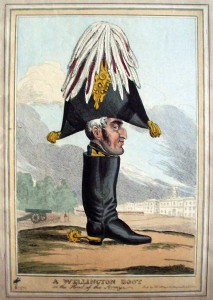Waterloo in poem, song and stage
Published in Uncategorized
A Wellington Boot or the Head of the Army, hand-coloured etching by William Heath, 1827. (Princeton University Library)
‘That day!—What grief, what glory, marked that day!
Tears dim our triumphs, triumphs dry our tears’.
Many songs and ballads published after 1815 took Waterloo as their theme. For example, in a collection of songs published in County Monaghan in 1822 there is a ballad of a woman mourning the loss of her loved one:
‘Low buried in oblivion beside many a hero too
There to decay and mould away on the plains of Waterloo’.
The battle of Waterloo, in all its scale and complexity, did not seem a likely subject for staging, but none the less it was attempted. In 1825, for the tenth anniversary, the Theatre Royal in Dublin staged a dramatic recreation of Waterloo. The real battlefield became a huge tourist attraction in the nineteenth century, and Irish people were among the most interested in visiting.
















